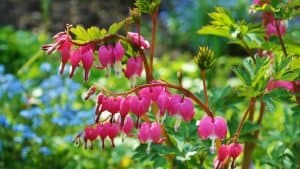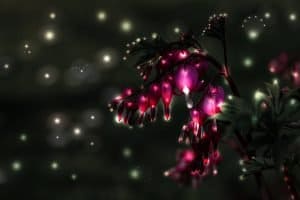What is the Bleeding Heart Plant?
No wonder how the old bleeding heart plant (Lamprocapnos Spectabilis) got its name. The flower is like a heart-shaped cushion with a hanging pendant drop. Bleeding hearts are woodland plants that bloom in the cold of spring. Although they remain in bloom for several weeks, the plants are often non-native, they disappear for the rest of the summer if kept to too much sun or heat. The roots are still alive and will return in the following autumn or spring. The varieties of fringed leaves will bloom again in the summer.

Bleeding hearts are an admirable choice for adding color and texture to shady locations or in the woods. All species have beautiful foliage, deeply cut with heart-shaped pink flowers that appear in spring. Various sizes are available, and hybrids have been developed over the years to extend the color range of flowers and increase the flowering period.
Scientific Classification of Bleeding Heart Plant
Kingdom: Plantae
Order: Ranunculales
Family: Papaveraceae
Genus: Lamprocapnos Endl.
Species: L. Spectabilis
Types of Bleeding Heart Plant
There are varieties of Bleeding Heart Plant differentiated based on the colors of their flowers.
- Lamprocapnos spectabilis ‘Alba.’
It has white heart-shaped flowers – these hang slightly from the arched flower stems between late spring and early summer. While it grows in light shade and looks nice to grow in clumps between shrubs, it is often even better on a sunny edge, provided the soil remains moist.
- Lamprocapnos Spectabilis’ Gold Heart.’
The Brilliant gold leaves and peached colored steams, Golden Heart is a graceful perennial that is fabulous to brighten the shady area. In blooms in late spring, elegant heart-shaped rose-pink flowers with white petals which dangle above the foliage.
- Dicentra Eximia ‘Fringed-leaf bleeding heart.’
The fringed bleeding heart is a beautiful native perennial found on forest floors, rocky forests, and slabs in the Appalachians. It prefers rich, moist, well-drained soils and does not like damp winter soil. Fern-like foliage and flowers appear in the spring and may continue to bloom in the summer. In warm climates, it can stop blooming in the summer and grow back in the fall.
- Dicentra Formosa ‘western fringed-leaf bleeding heart’
Fringed bleeding heart plants range height of 12 to 18 inches with a similar spread. In addition to its romantic-shaped flowers, which come out for the first time in spring, these perennials are respected for their gray-green, very thorny leaves. Some flowers are hanging along a leafless stem. The color is often pink or reddish-purple flowers. Alba is a white-flowered cultivar of wildflowers.

- Dicentra cucullaria ‘Dutchman’s breeches’
Dutch breeches are a real asymmetric species of spring woods. It blooms in early spring when sunlight hits the forest floor before filling the crown of the tree. It is an excellent time for the first emerging bumblebees to find flowers and their nectar. In early summer, the green foliage (reminiscent of fern-like leaves) will fade to a pale yellow and eventually become dormant by mid-summer.
How to Grow Bleeding Heart?
A bleeding heart prefers a shady spot in the garden with fertile, slightly moist soil. Under the right conditions, some bleeding hearts can grow 3 to 4 feet, so it may be necessary to put them together to prevent plants from spreading over their neighbors.
Bleeding hearts can be started from seed, division cut, or seedling. To start the seeds indoors, put the seeds in an earthen pot. Put the pot in a plastic bag and put it in for 6-8 weeks. Remove the pot and everything to germinate and grow in normal seedling conditions.
Growing from Division
It is very easy to divide the bleeding heart plants. Bleeding hearts should be divided after flowering, so as not to sacrifice the bloom. The varieties of fringed leaves divide well in early spring as they emerge. So, it is best to do it in autumn or early spring to get the best plants.
Growing from Seed
The bleeding heart can be started with seed or stem cuttings. Plants often reproduce throughout your garden, even if they are not a nuisance. Sow outdoors in the fall; the seeds need a period of cool temperatures. The best time to plant them is from autumn to early spring.

Here is a video on how to propagate Bleeding heart
How to care for Bleeding Heart?
Soil
Bleeding heart plants require moist and fertile soil, rich in neutral or slightly alkaline humus.
Light
Bleeding hearts are best on the partial shade. Because it’s so early in bloom, planting near a deciduous tree is a good place. Plants will grow and grow before the tree leaves, and when the bleeding heart needs protection from the summer sun, the tree will provide it.
Watering
From spring to winter, water regularly to keep the soil moist but not immersed. Bleeding hearts do not tolerate wet soil in winter or dry soil in summer.
Fertilizer
There are no serious disease or pest problems, although aphids can be sensitive. Protect new growth from slugs. Fertilize depends on the quality of your soil. If you have a rich organic soil that is changed every year, you won’t have to feed the plant at all.
Uses of Bleeding Heart
- Native Americans in the Pacific Northwest have used bleeding hearts for generations as a cure for toothache and other forms of pain.
- In past years, a bleeding heart has been used extensively to treat syphilis.
- Michael Moore, the author of Western Pacific Medicinal Plants, reports that a tincture of cardiac bleeding or cardiac rhizomes if taken internally, helps relieve frazzled nerves.
- If applied externally and covered by a warm and moist compression, it relieves the pain of sprains, strains, and bruises.
Where can I buy Bleeding Heart plants?
You can find bleeding heart plants for sale in your near nurseries and florists. You can also buy bleeding heart seeds from Amazon or Etsy, online stores. If you wish to buy a dwarf bleeding heart plant, you can find them on amazon.
Potential Hazard of Bleeding Heart
The plant can cause skin irritation to some people.

Amelia is a plant and nature lover! Ever since she was little, she loved spending time in her family’s garden and learning about how to care for each plant individually. As an adult, she has dedicated herself to sharing what she has learned and continuing to expand her knowledge on the plant kingdom.
